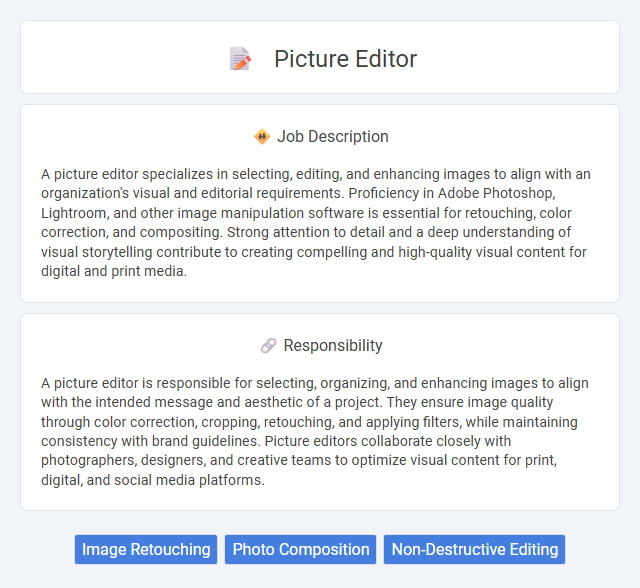
A picture editor specializes in selecting, editing, and enhancing images to align with an organization's visual and editorial requirements. Proficiency in Adobe Photoshop, Lightroom, and other image manipulation software is essential for retouching, color correction, and compositing. Strong attention to detail and a deep understanding of visual storytelling contribute to creating compelling and high-quality visual content for digital and print media.
People with a strong attention to detail and a passion for visual storytelling are likely to be well-suited for a picture editor job. Those who can work efficiently under tight deadlines and adapt to rapid feedback may find success in this role. Individuals who struggle with precision or lack interest in creative collaboration might face challenges in meeting the demands of this position.
Qualification
Proficiency in advanced photo editing software such as Adobe Photoshop, Lightroom, and Capture One is essential for a Picture Editor. Strong understanding of color correction, retouching, and image composition enhances visual storytelling and ensures high-quality output. Experience in managing large image libraries and collaborating with creative teams improves workflow efficiency and project delivery.
Responsibility
A picture editor is responsible for selecting, organizing, and enhancing images to align with the intended message and aesthetic of a project. They ensure image quality through color correction, cropping, retouching, and applying filters, while maintaining consistency with brand guidelines. Picture editors collaborate closely with photographers, designers, and creative teams to optimize visual content for print, digital, and social media platforms.
Benefit
Picture editor positions likely offer benefits such as enhanced creativity and skill development through constant image refinement. Opportunities for collaboration with photographers and designers may increase, resulting in diverse project experiences. The role probably provides a sense of accomplishment when transforming raw images into visually appealing content.
Challenge
Picture editor jobs often present the challenge of balancing creativity with technical precision, requiring a keen eye for detail to enhance image quality effectively. The role may involve adapting to rapidly changing software tools and evolving industry standards, which could demand continuous learning and flexibility. Managing tight deadlines and client expectations increases the likelihood of encountering high-pressure situations requiring swift problem-solving skills.
Career Advancement
Picture editors can advance their careers by mastering advanced photo editing software such as Adobe Photoshop and Lightroom, gaining expertise in color correction, retouching, and visual storytelling. Building a strong portfolio that showcases diverse editing styles and collaborating with photographers, designers, and marketing teams enhances opportunities for higher-level roles like senior editor or creative director. Continuous learning through workshops and certifications in digital imaging technologies significantly boosts career growth and industry recognition.
Key Terms
Image Retouching
Picture editors specializing in image retouching enhance photographs by correcting color, removing imperfections, and adjusting lighting to achieve a polished final product. Proficiency in software such as Adobe Photoshop and Lightroom is essential for detailed manipulation of images, including skin smoothing, background cleanup, and object removal. Expertise in retouching not only improves visual appeal but also ensures consistency across visual media for marketing, advertising, and digital platforms.
Photo Composition
A picture editor specialized in photo composition expertly arranges visual elements to enhance the storytelling and aesthetic appeal of images. Mastery of principles such as rule of thirds, symmetry, and balance ensures each photograph conveys the desired mood and draws viewer attention effectively. Proficiency in advanced editing software like Adobe Photoshop and Lightroom supports seamless integration of visual components to produce compelling, high-quality photographs.
Non-Destructive Editing
Picture editors specializing in non-destructive editing utilize advanced software tools such as Adobe Photoshop and Lightroom to preserve original image data while applying adjustments. Techniques like layer masks, adjustment layers, and smart objects enable reversible changes, maintaining the photograph's integrity and flexibility for future modifications. Mastery of these methods enhances workflow efficiency and ensures high-quality, editable image outputs for professional photography and digital media projects.
 kuljobs.com
kuljobs.com